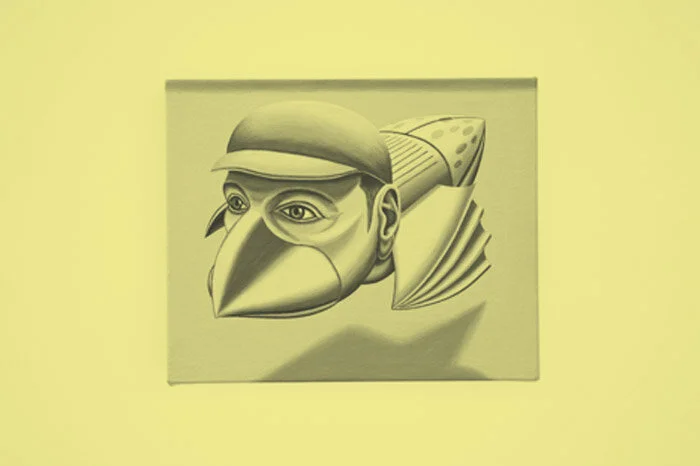#76 Simon Granger, Waxwings
2 - 21 May
Simon Granger was born in London. He graduated from the Slade School of Fine Art in 1979. Granger currently lives and works in London.
A conversation between Simon Granger and Jacques Rogers on 30th April 2011
Jacques Rogers: Hi Simon. Before speaking about the show it seems important to first position Waxwings in relation to a very specific ongoing body of work involving the painting of hybrid creatures that date from the mid 1990’s...
Simon Granger: Hi Jacques. The hybrids go even further back, and in some ways the series is seamless up to the present, with the works evolving in phases and groups. The first works strategically using animal hybridity were done when I was a student, then there was a long period of other works, until this ongoing series emerged. At Outpost I wanted to give a sense of the series, together with the newest developments, which are a move towards increasing ‘humanisation’ of the hybrids – from animal to animal fusions, I think of them now as animal-human entities, like flying human-insects.
JR: I think there is something interesting happening in these works that relates to the idea of representation in painting, particularly in regards to their relationship with reality. Maybe this has something to do with the difficulty one has in locating familiar points of reference?
SG: I agree. I’m interested in going further and further into the territory of illusionism and overt representation, pursuing my ongoing delight with the perhaps elementary phenomenon and trickery of illusion, which so far has never failed to entice me. And part of this is of course enjoying the paradox that the more the images fool you by their illusion of realism, the more false and artificial they become. And you’re right that setting up various kinds of disorientation is important; for example I want the images to be utterly clear in form, but extremely ambiguous in implication.
JR: The effect of this is both disorientating and disconcerting as the viewer struggles to understand the agency underlying the work – perhaps this is echoed in your choice to build a redundant wall that greets visitors as they cross the threshold into the gallery, obscuring their view of the space?
SG: I certainly wanted the wall to slow people’s progress into the space, and delay the moment they see the work, although we were all careful not to turn the wall into a sculpture. I also wanted to create an intimate space, a light-filled cube, in which to view (or choose not to) tiny, elaborately made pictures. And so you’re right, the wall adds further disorientation by cutting the paintings off that bit further from the rest of the world – of providing no further cues or distractions.
JR: Through your focused, persistent rendering and repetition of these idiosyncratic creatures the images (for me) become a commentary on painting as a practice. If this is the case, could you say a little about your relationship with painting and how it has informed the form and content of Waxwings.
SG: My relationship to painting? Complicated, would be one answer. I understand as an inevitability that painting involves a love-hate (more love than hate) relationship with its own glorious and inglorious past, and I love the narrowness of the convention of painting, its fragility, both literally, as a precarious stretched surface and an illusion ready at any moment to be shattered or disbelieved, and metaphorically – in the sense of painting’s continued existence as a permanently-endangered species, continually declared dead, but resurrecting, twisting and turning in response to rival media and cultural appetites, currently to global, flexible, omnivorous and instantaneous digitisation; and painting is still creatively in thrall to the ageing upstart medium of photography. So, I think my fragile, absurd, crazily lovingly- crafted, seemingly innocent, small, vulnerable images, that look both backwards into history and forwards – these characteristics might be some kind of current incarnation of the characteristics of painting practice.




